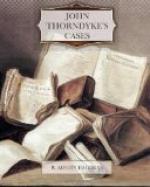“Did you notice anything remarkable about the footprints in the sand?”
“I did,” replied Dr. Burrows. “They were the footprints of two persons only. One of these was evidently the deceased, whose footmarks could be easily identified by the circular rubber heels. The other footprints were those of a person—apparently a man—who wore shoes, or boots, the soles of which were studded with nails; and these nails were arranged in a very peculiar and unusual manner, for those on the soles formed a lozenge or diamond shape, and those on the heel were set out in the form of a cross.”
“Have you ever seen shoes or boots with the nails arranged in this manner?”
“Yes. I have seen a pair of shoes which I am informed belong to the accused; the nails in them are arranged as I have described.”
“Would you say that the footprints of which you have spoken were made by those shoes?”
“No; I could not say that. I can only say that, to the best of my belief, the pattern on the shoes is similar to that in the footprints.”
This was the sum of Dr. Burrows’ evidence, and to all of it Thorndyke listened with an immovable countenance, though with the closest attention. Equally attentive was the accused man, though not equally impassive; indeed, so great was his agitation that presently one of the constables asked permission to get him a chair.
The next witness was Arthur Jezzard. He testified that he had viewed the body, and identified it as that of Charles Hearn; that he had been acquainted with deceased for some years, but knew practically nothing of his affairs. At the time of his death deceased was lodging in the village.
“Why did he leave the yacht?” the coroner inquired. “Was there any kind of disagreement!”
“Not in the least,” replied Jezzard. “He grew tired of the confinement of the yacht, and came to live ashore for a change. But we were the best of friends, and he intended to come with us when we sailed.”
“When did you see him last?”
“On the night before the body was found—that is, last Monday. He had been dining on the yacht, and we put him ashore about midnight. He said as we were rowing him ashore that he intended to walk home along the sands us the tide was out. He went up the stone steps by the watch-house, and turned at the top to wish us good-night. That was the last time I saw him alive.”
“Do you know anything of the relations between the accused and the deceased?” the coroner asked.
“Very little,” replied Jezzard. “Mr. Draper was introduced to us by the deceased about a month ago. I believe they had been acquainted some years, and they appeared to be on excellent terms. There was no indication of any quarrel or disagreement between them.”
“What time did the accused leave the yacht on the night of the murder?”
“About ten o’clock. He said that he wanted to get home early, as his housekeeper was away and he did not like the house to be left with no one in it.”




